Exploring the Burj Khalifa Fountains: A Masterpiece
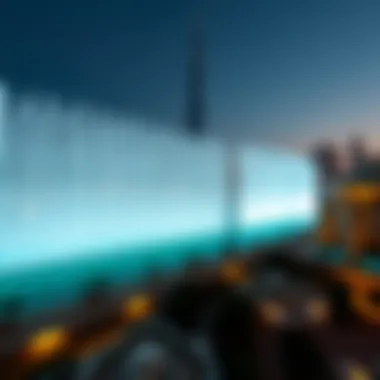
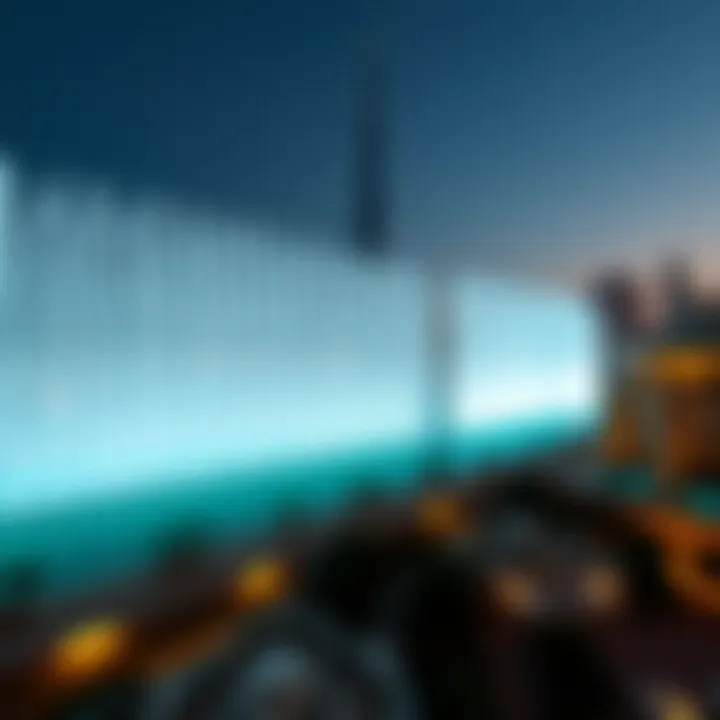
Market Insights
The skyline of Dubai is not just a collection of tall structures; it embodies ambition and aspiration. At the heart of this bustling metropolis stands the Burj Khalifa, a testament to innovative architecture and design. A critical aspect that enhances this towering marvel is the spectacular fountains that dance gracefully at its base. These fountains are not merely an aesthetic feature; they play a significant role in the real estate landscape surrounding the Burj Khalifa.
Current Trends in Dubai Real Estate
In recent years, the property market in Dubai has seen fluctuations, but the allure of luxury living near landmarks like the Burj Khalifa remains strong. The segment closest to the fountain area has increasingly attracted high-net-worth investors. Properties in such prime locations tend to hold their value better than those further from key attractions.
Some notable trends affecting the Dubai real estate market include:
- Growing Interest from Foreign Investors: The easing of property ownership laws for non-residents has allowed more people to invest in Dubai real estate.
- Luxury Market Resilience: High-end properties, particularly near the Burj Khalifa, continue to see demand despite economic uncertainties, often resulting in increased valuations.
- Short-Term Rentals Surge: The hosting of global events, such as EXPO 2020, has boosted the short-term rental market, with many tourists seeking accommodations close to the fountains.
Property Valuation and Future Predictions
Locating a property in the vicinity of the Burj Khalifa’s fountains can be quite advantageous. The proximity to such an architectural wonder significantly influences property valuations. As interest in Dubai's luxury market peaks, a few predictions can be made:
- Steady Appreciation in Value: Properties near the fountains are likely to experience a gradual appreciation in value, making them solid investments for both short-term and long-term investors.
- Potential for Higher Rental Yields: Given the high foot traffic and the allure of the Burj Khalifa’s fountains as a tourist attraction, rental properties can command higher rates, impacting overall return on investment (ROI).
- Urban Development Projects: Ongoing urban development initiatives in Dubai will only add to the desirability of these areas, possibly leading to further price increases.
According to the Dubai Land Department, properties around the Burj Khalifa have seen as much as a 10% increase in value over the past year, highlighting their investment potential.
In summary, the fountains of Burj Khalifa are not merely a visual delight but represent an underlying dynamism in the Dubai property market. With a growing influx of investors and an enduring appeal for tourists, properties nearby hold promise for both appreciation and rental income.
Intro to the Burj Khalifa Fountains
The fountains of Burj Khalifa are not just a decorative touch; they’re the heart of Dubai's urban essence. As one gazes up at this towering marvel, the fountains create a captivating interplay between water and light, establishing a harmony that defines the experience of downtown Dubai. Their significance traverses the realms of art, technology, and even local culture, making them worthy of detailed exploration.
A Brief History of Burj Khalifa
The story of Burj Khalifa starts not just with its ambitious construction but also with its culture that mirrors Dubai’s rapid rise. Originally known as Burj Dubai, construction on the tower began in 2004. The purpose? To create a structure that represented the aspirations of a city striving for grandeur. After several years of diligent engineering and construction, Burj Khalifa was inaugurated on January 4, 2010. Standing at a staggering height of 828 meters, it became the world’s tallest building, surpassing its predecessors significantly. The architectural vision of Adrian Smith was essential to its development, drawing inspiration from Islamic architecture, particularly the desert flower. This flower's form resonates through the tower’s design, creating a seamless blend between nature and human ingenuity.
Overview of the Fountain System
The design of the fountain system at Burj Khalifa is nothing short of revolutionary. Acclaimed as the largest choreographed fountain system in the world, it features jets that reach heights of up to 150 meters. This impressive feat is possible thanks to state-of-the-art technology, which controls the movement of water with precision. The fountains are arranged over a 30-acre manmade lake, and their performance is choreographed to various music genres—it’s as if the water dances to an unseen rhythm. The fountains perform daily, attracting thousands of spectators who gather to witness this mesmerizing spectacle.
"The Burj Khalifa fountains exemplify the potential of merging natural elements with architectural prowess, highlighting Dubai's innovative spirit."
The lighting that complements the fountain displays includes over six thousand lights and twenty-five colored projectors. This combination creates a vivid tableau that enhances the visual allure of the performance. The water not only dances but does so with the help of sophisticated nozzles and high-pressure technology, ensuring an awe-inspiring experience. Visitors can enjoy this artistic movement from various viewing spots around the lake, making it a focal point for both tourists and locals alike.
Design Elements of the Fountains
Understanding the design elements of the fountains at Burj Khalifa reveals not just their aesthetic appeal but also the intricate thought processes behind their creation. These fountains are not merely a spectacle of water and light; they are a cohesive element of the experience that the Burj Khalifa offers, contributing significantly to the overall atmosphere of the area. What stands out is their ability to draw in crowds, making the fountains a focal point for both tourism and local life.
Architectural Inspiration
The design of the fountains draws heavily from various sources of inspiration that reflect both local culture and contemporary aesthetics. The fountain bursts and jets resemble the rippling waves of the Arabian Gulf, evoking a connection to the water that is integral to Dubai's identity. The fluidity of water is mimicked in the forms and movements of the fountains, creating a sense of harmony in the environment. The architects infused traditional influences with modern techniques, aiming for a seamless blend that honors the past while embracing the future.
For instance, the patterns of the fountain jets can be interpreted as reminiscent of the designs found in Islamic art, where geometry and symmetry play crucial roles. This gives the fountains a layer of cultural context that enriches the experience for every onlooker. The visual poetry of their movements translates diverse narratives into a unifying spectacle, allowing everyone to resonate with the essence of Arabian elegance.
Water and Light Dynamics
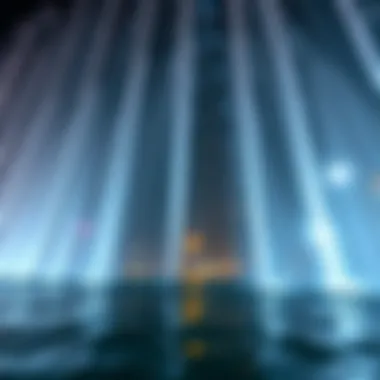

One of the defining features of the Burj Khalifa fountains is the interplay of water and light, which transforms them into a mesmerizing display. Each performance utilizes a complex choreography of water jets soaring up to 150 meters, which is accompanied by an array of colored lights and music. This dynamic relationship brings an artistic dimension to the phenomenon, where light dances off the water, creating a kaleidoscopic effect that captivates audiences.
The success of this dynamic relies heavily on advanced technology. The system is built with an ability to precisely control both the water jets and lighting in synchronization with soundtracks. This ensures that no two performances are alike, as every show can reflect different themes or moods. Additionally, the use of energy-efficient LED lights underscores a commitment to sustainability, balancing spectacle and environmental considerations. By calibrating these elements, the fountains can evoke emotions, captivate viewers, and heighten the experience of those gathered.
Integration with Surroundings
The integration of the fountains with their surroundings has been executed with meticulous planning. This is not simply about placing them in a desirable location; it's about creating a canvas where the Burj Khalifa itself becomes more than a mere structure. The fountains sit proudly in the Burj Lake, which is meticulously landscaped to complement their splendor.
Moreover, pathways and seating areas have been designed to ensure that visitors enjoy unobstructed views, creating a communal space that enhances social interactions. The setting encourages not just spectatorship but engagement, where people come together to watch the various performances, share experiences, and create lasting memories.
The sensory experience is further amplified by the reflections of the Burj Khalifa and surrounding buildings on the water's surface, tying the fountains to the skyline itself. This thoughtful integration of architectural features allows for a cohesive urban space that feels both lively and idyllic, attracting residents and tourists alike.
These design elements weave a narrative that highlights not only technological advances but also cultural resonance, making the fountains an undeniable aspect of what defines the Burj Khalifa and its surrounding landscape.
Engineering Challenges and Innovations
The Burj Khalifa fountains are not just a visual treat; they represent a pinnacle of engineering achievements that required overcoming various hurdles. This section highlights how remarkable innovation and technical ingenuity came into play to bring the vision of these spectacular fountains to life.
Technical Specifications
When discussing the fountains at Burj Khalifa, the technical specifications reveal the impressive scale of this project. The fountain system is the largest choreographed fountain show in the world, stretching over 275 meters in length. The water jets can shoot up to 150 meters high, creating a stunning spectacle against the backdrop of the tallest building on Earth.
Key Features:
- Water pumps: Approximately 6,600 liters of water can be propelled into the air per minute.
- Light and sound equipment: The show is synchronized with an array of detailed lighting and sound effects, making each performance not simply about water but an entire sensory experience.
- Control systems: The fountains incorporate advanced control systems that integrate various algorithms to ensure precise choreography of the water jets.
The design demands continuous innovation to manage such powerful systems effectively while ensuring seamless performance.
Weather Resistance Factors
The Middle Eastern climate, known for its extreme temperatures and high wind conditions, posed significant challenges in maintaining the fountain’s operations. Factors such as dust storms and frequent heat waves required engineers to innovate solutions that would ensure not only functionality but also longevity.
For instance, the materials selected for the pumps and electrical systems were specially chosen for their resistance to corrosion and damage from the local weather conditions. Flexibility was key; the fountains were designed to withstand wind gusts without affecting performance, thus creating a steady flow of the water show despite adverse conditions.
"Weather conditions required engineers to think outside the box, coming up with solutions that maintain functioning efficiency while embracing the beauty of the show."
This consideration extends into the minor day-to-day maintenance procedures, which also have to be adaptive with changing weather patterns.
Sustainability Considerations
As more cities lean towards eco-friendliness, the Burj Khalifa fountains also reflect a commitment to sustainability. The strategy is multifaceted, focusing on conserving water while maximizing aesthetic impact.
Sustainable Practices:
- Water recycling: The fountains utilize recirculated water, drastically reducing the amount of fresh water needed for operation. This practice not only conserves water but also lowers long-term operational costs.
- Solar power initiatives: Future projects may consider integrating solar panels to power some of the lighting systems, aligning with global sustainability efforts without compromising quality and beauty.
- Energy-efficient lights: LED technology is employed for lighting. This ensures lower energy consumption while still producing vibrant colors that enhance the fountain’s performances.
These considerations underscore the dual priorities of engineering excellence and environmental stewardship. The Burj Khalifa fountains not only elevate the skyline but also demonstrate how innovative design can address contemporary ecological concerns.
In summary, the fountains embody a blend of creative engineering, weather adaptability, and sustainable practices, challenging preconceptions of what a modern fountain system can be.
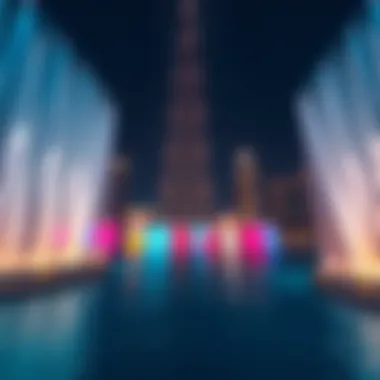
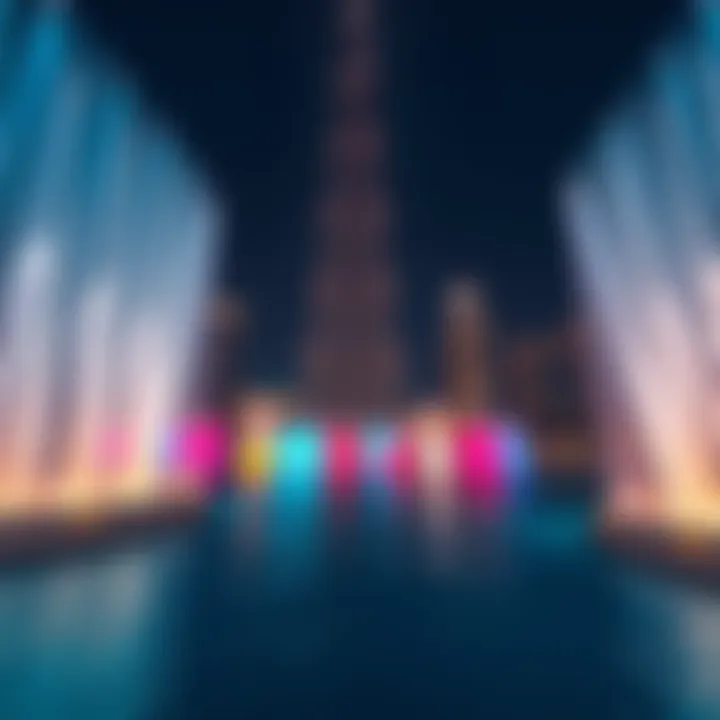
Cultural Significance and Impact
The fountains at Burj Khalifa are not just a spectacle; they hold deep cultural significance and economic impact for Dubai and the broader Emirati identity. These fountains do more than perform choreographed water ballets; they embody the values, aspirations, and innovative spirit of a nation. Understanding their multifaceted role helps paint a vivid picture of how they integrate into the fabric of society.
Symbolism in Emirati Culture
In Emirati culture, water symbolizes life and prosperity. The fountains elegantly reflect this cultural connection, serving as a reminder of the harsh desert landscape that characterizes much of the region. Since ancient times, water has been revered, and these fountains bring this age-old appreciation into the modern era.
They represent not just beauty but also a triumph over nature, showcasing human ingenuity in harnessing resources effectively. The calming sound of water dancing in the air resonates with the local ethos of hospitality and community, making it a space where people gather, celebrate, and share stories.
This blend of art and culture speaks volumes about the national identity, where traditions meet modern aspirations.
Role in Tourism Development
Tourism is lifeblood for Dubai's economy, and the fountains play a pivotal role in attracting visitors worldwide. With their intricate designs and mesmerizing performances, they have become a must-see feature for tourists flocking to the city. The nightly shows draw crowds from hotels, restaurants, and nearby attractions, creating a lively atmosphere that enhances the overall experience of Dubai.
Some key points regarding the fountains' impact on tourism include:
- Increase in Foot Traffic: The allure of the fountain shows has resulted in a surge of visitors, contributing significantly to local businesses.
- Iconic Status: The Burj Khalifa fountains, in conjunction with the tower itself, have solidified Dubai's status as a global tourist destination, promoting the city's image as a center of luxury and innovation.
- Cultural Events: Hosting festivals and events around the fountains creates an engaging experience for locals and visitors. This integration of art and culture fosters a unique cosmopolitan environment that reflects both local and international influences.
Interactions with Local Communities
The fountains are more than an attraction; they have become a cornerstone of community interaction. They are spaces where families gather, friends meet, and cultures converge, fostering a sense of belonging and community pride. Over time, these gatherings have led to the fountains being woven into the social lives of many residents.
Notably, various community programs are centered around the fountains, promoting local artists, musicians, and even traditional Emirati performances. These initiatives not only entertain but also educate visitors about Emirati culture and heritage, creating an atmosphere of mutual respect and understanding.
Essentially, the fountains serve as a bridge that connects diverse cultures, making Dubai a melting pot of experiences—from melodious water displays to street performances that celebrate local traditions. This community-oriented approach reinvigorates local culture while also inviting outsiders to share in it.
"The fountains at Burj Khalifa are not just a view; they are a vibrant mosaic of culture and community interaction that exemplifies the spirit of Dubai."
Experiencing the Fountains
Experiencing the fountains at Burj Khalifa is one of the highlights for visitors and locals alike. More than just a spectacle, the fountains serve as a point of connection, drawing people in with their mesmerizing choreography of water, light, and music. This section aims to delve into the specific aspects that contribute to the overall experience, showcasing the important role these fountains play in Dubai's vibrant cultural and social landscape.
Best Viewing Locations
The location from which one views the fountains can greatly impact the experience. Here are some prime spots:
- Burj Lake: Standing right at the edge of the lake provides an unfiltered experience, as the water dances to the rhythm beneath your feet. The sights and sounds blend together to create a symphony of sensations.
- Souk Al Bahar: This shopping and dining destination offers some of the most picturesque views. Patrons can enjoy a meal while catching the shows, providing a blend of gastronomy and entertainment.
- The Dubai Mall: From various vantage points within this vast shopping complex, visitors can enjoy the fountains. Some areas access an elevated view that enhances the beauty of the displays.
- At the Top, Burj Khalifa: For a unique perspective, head to the observation decks. Seeing the fountains from above allows for a different appreciation as the show unfolds against the city backdrop.
- Boat Ride: Consider taking a small boat ride on Burj Lake for an intimate experience. Being on the water during a performance creates an unforgettable connection with the spectacle.
Timing and Performances
Timing is crucial to experiencing the fountains at their best. Performances occur daily, starting in the evening as the light transitions. Shows usually happen every 30 minutes, featuring various musical selections, from classical compositions to contemporary hits. The choreography changes with the music, creating a unique experience each time. Here’s a helpful breakdown:
- Evening Shows: Beginning at 6 PM and continuing until 11 PM.
- Daytime Displays: A limited number of daytime shows also occur.
- Seasonal Performances: Special occasions, such as holidays, may have extended shows with exclusive music selections.
Keep an eye on the schedule as it can vary during holiday seasons or significant events in Dubai.
Guided Experiences
For those seeking a deeper understanding of the fountains, guided experiences are an excellent option. Knowledgeable guides provide insights into the fountain's engineering, artistic inspiration, and cultural significance. Here are a few options:
- Walking Tours: Join a local guide for a comprehensive journey through the area, learning not just about the fountains but also other key features of the Burj Khalifa complex.
- Dinner Packages: Some restaurants offer dinner packages that include reserved seating for the fountain shows, combining fine dining with mesmerizing performances.
- Photography Tours: Tailored for photography enthusiasts, these tours often focus on capturing the fountains in various lights, making for fantastic memories.
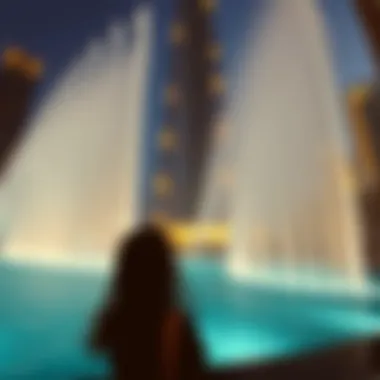
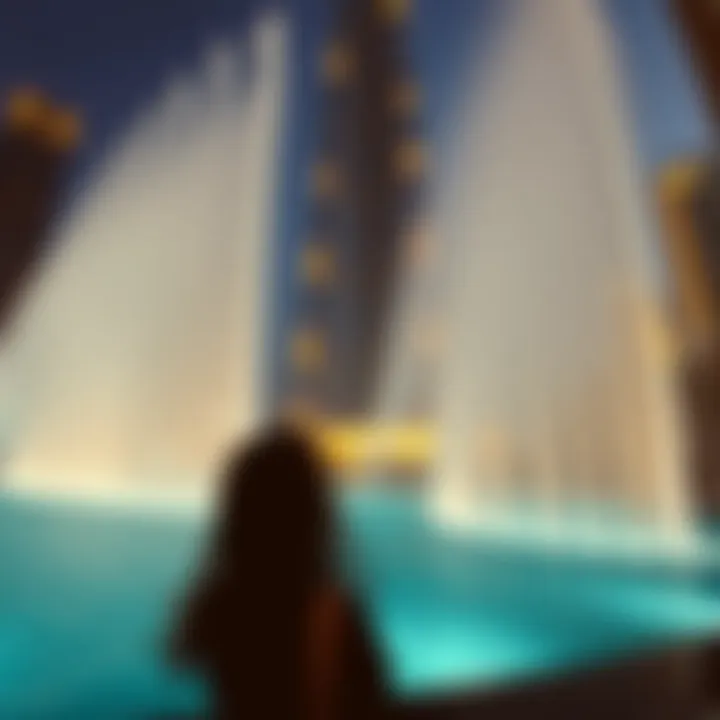
In summary, experiencing the fountains at Burj Khalifa can be a rich tapestry of sensory and social interaction. Whether you prefer to sit back at a restaurant with a view or actively participate in guided tours, the fountains offer various angles from which to savor this architectural and artistic wonder.
Economic Implications
When discussing the fountains of the Burj Khalifa, one cannot overlook their substantial economic impact. These stunning water displays are not just a visual spectacle but also a catalyst for economic activities in the surrounding area. From boosting local real estate values to opening doors for investments, the fountains play a pivotal role in shaping the economic landscape of Dubai.
Impact on Nearby Real Estate
The presence of the Burj Khalifa fountains has transformed the real estate dynamics in its vicinity. Properties located close to the fountains command higher prices, serving as an alluring draw for homebuyers and investors alike. The scenic views that these properties offer can turn any ordinary apartment or commercial unit into a premium listing.
- Increased Demand: With their breathtaking displays, the fountains attract not only tourists but potential homebuyers. Properties in the nearby Downtown Dubai area see a surge in demand, as many desire to enjoy the attractive surroundings.
- Value Appreciation: Real estate within proximity to the fountains has shown a trend of significant appreciation over time. This rising value often reflects the prestige associated with living near one of the world's architectural marvels.
- Commercial Aspect: Businesses, especially those in hospitality or retail, find it beneficial to be in close range to the fountains. High footfall from tourists and locals seeking views of the shows can translate into improved sales and foot traffic for shops and restaurants.
Investment Potential in the Area
Investors keen on tapping into Dubai's thriving market should seriously consider properties near the Burj Khalifa fountains. The intersection of tourism and real estate generates a unique investment opportunity that is hard to overlook.
- Rental Yields: The proximity to the fountains can dramatically increase rental yields, making properties highly attractive for investors looking for steady income. Short-term rentals, such as those offered through Airbnb, can also fetch premium prices during peak tourist seasons.
- Future Development: The continued growth of Dubai as a global hub ensures ongoing interest in properties near the fountains. Upcoming residential and commercial developments are likely to further enhance the investment landscape, creating a ripple effect of economic stimulation.
- Real Estate Trends: Monitoring market trends in and around the fountain area can provide investors with insights on the best times to buy or sell. Reviews of sales data and growth forecasts indicate ongoing robust demand.
"The Burj Khalifa fountains are a magnet for both tourists and investors, creating a unique synergy that enhances the value of real estate in the area."
Future Prospects
As the iconic Burj Khalifa continues to define the skyline of Dubai, the fountains beneath it are poised for a future that holds promising potential. These aren't just mere water features; they embody the vision of an ever-evolving architectural and engineering spectacle designed to enhance the city’s cultural and economic fabric. Investors, realtors, and even homebuyers have a keen interest in tracking how these attributes will grow and develop. Understanding the future prospects of the fountains involves a nuanced examination of technology, visitor engagement, and urban development strategies.
Technological Advances on the Horizon
In today’s fast-paced world, technology plays a pivotal role in maintaining and enhancing tourist attractions. The Burj Khalifa fountains are likely to embrace advanced technologies to elevate their already spectacular performances.
Some expected advancements may include:
- Smart Water Management Systems: Incorporating IoT to monitor water usage will ensure sustainability, allowing the fountains to provide magnificent displays while conserving resources.
- Interactive Displays: The integration of augmented reality could transform the experience for visitors. Imagine holding up your smartphone to see visual explanations about the show’s synchronization with music or background stories of the UAE!
- Enhanced Lighting Features: Upgrading to energy-efficient LED systems can create more vibrant colors and seamless transitions, captivating audiences during performances.
The potential of using dynamic technology is not just limited to aesthetic value; these improvements could also assist in reducing operational costs and increasing the lifespan of the infrastructural elements.
Plans for Expansion or Upgrades
Plans for expansions or upgrades can significantly reshape the landscape around the fountains, enhancing their appeal and functionality. The following considerations are paramount:
- New Viewing Platforms: Expanding public spaces with new balconies or terraces around the fountain area could offer panoramic views, making it even easier for tourists and residents to enjoy the shows.
- Integration with Surrounding Developments: Future construction nearby may emphasize the fountains as a central element in urban design. For example, cafes, restaurants, or shopping areas that open to the fountain view would enrich the communal experience and encourage more foot traffic.
- Cultural Shows and Events: Engaging local artists for seasonal performances, such as live music or light shows synchronized with cultural festivities, may create a more appealing environment to visitors, thereby increasing tourism and local economic growth.
"Future upgrades can add even greater layers of depth to what is already a visual masterpiece, potentially securing the fountains' role as a beacon of innovation and culture in Dubai."
As the Burj Khalifa fountains strive to keep up with the changing tides of architectural advancement, the foresight of both technology and expansion plans is essential. Whether it’s through improved visitor experience or economic implications, the next chapter of this enchanting water display is likely to be just as compelling as its incredible beginning.
The End
The Burj Khalifa fountains represent not just a display of artistic craftsmanship but a significant thread woven into the fabric of Dubai’s identity. These water features are more than mere attractions; they fuel local tourism, contribute to a vibrant community life, and symbolize the cities' aspirations in seamlessly blending modernity with tradition.
Reflecting on the Journey of the Fountains
The journey of the fountains began from an ambitious vision of creating a spectacle unlike any other. The design, inspired by the natural movements of water, reflects the harmony sought between technology and nature. As one gazes at the dancing jets, it's easy to appreciate how they push the boundaries of engineering while adhering to aesthetic appeal. The choreographed performances, synchronized to music, bring together thousands of spectators, uniting them in shared experiences that resonate beyond mere sight.
Moreover, the fountains offer a glimpse into the future with their focus on sustainability and innovation. They showcase what’s possible when engineering meets artistic expression. As urban landscapes evolve, these fountains serve as reminders of how public art can elevate communal spaces, encouraging social interactions and enhancing the quality of life in a bustling metropolitan environment.
In essence, this journey underscores the significance of the fountains not just within the bounds of architectural prowess, but also as a catalyst for community engagement and cultural appreciation. They remind us that what might start as a project can evolve into a vital part of a city's heartbeat. The interplay of water, light, and sound tells stories that connect residents and tourists alike, solidifying the fountains’ place in the future of Dubai.











